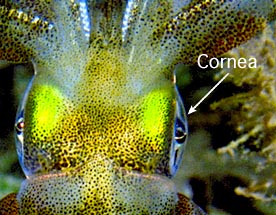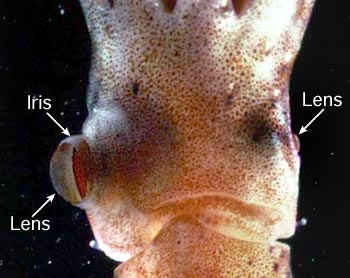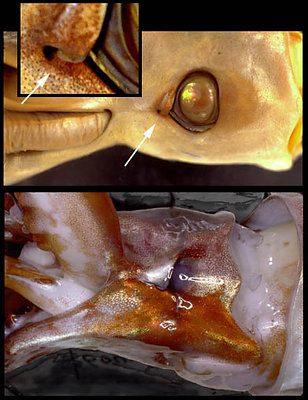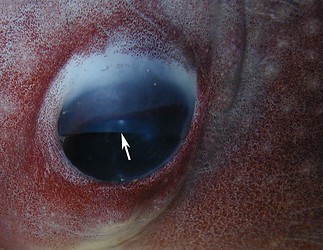Cephalopoda Glossary

Click on an image to view larger version & data in a new window

Decapodiforms have two types of eyes: those with and those without a cornea.The cornea is essentially an eyelid that has become transparent and turgid and permanently covers the lens. The opening of the eyelid is reduced to a microscopic pore or is absent. Squids without a cornea have the lens exposed to seawater. The latter squids, however, have a functional eyelid.

Click on an image to view larger version & data in a new window

Figure. Dorsal view of the head of the squid, Sepioteuthis australis (Fam. Loliginidae) which has a cornea. The lens, which is partially covered by a complex iris, can be seen inside the cornea. Photograph, by Mark Norman.

Click on an image to view larger version & data in a new window

Figure. Dorsal view of the head of the squid Stigmatoteuthis hoylei (Fam. Histioteuthidae) which lacks a cornea. This squid that has eyes of two different sizes which makes the lens easier to see on the large eye. Photograph of by R. Young.
Eyelids and eyelid sinus. Squids without a cornea have an eyelid that can close over the lens. The eyelid can be transparent and is occasionally confused with a cornea. However, a large, complex slit remains that marks the edges of the closed eyelids.

Click on an image to view larger version & data in a new window

Figure. Side views of the heads of Sthenoteuthis oualaniensis (top) and Ommastremphes bartramii (bottom). Photographs modified from: Young, R. E., M. Vecchione and D. Donovan (1998)
The top large photograph is the head of a preserved squid,
Sthenoteuthis oualaniensis. The white arrow points to the eyelid sinus. The insert photograph is an enlargement of the eyelid sinus from the first photograph. The eyelid sinus complex appears to enable complete closure of the eyelid. This is seen in the lower picture of a live squid,
Ommastrephes bartramii, which is very closely related to
Sthenoteuthis oualaniensis. The photographer had just touched the eyelid of this squid and it immediately responded by closing the eyelid. Note how the eyelid closed: The posterior edge of the eyelid expanded anteriorly providing most of the closure. The dorsal and ventral margins contracted and the flap over the eyelid sinus expanded to cover the remaining, slit-like opening. Probably a circular eyelid drawn together from all sides equally would not be able to close completely but would leave an central pore exposed.
Octopodiformes: Most cephalopods in this group have eyes with a two-part cornea formed of an upper transparent lid that overlaps a lower transparent lid.

Click on an image to view larger version & data in a new window

Figure. Lateral view of the left eye of the incirrate octopod Graneledone verrucosa, fresh specimen, showing the ventral edge of the upper corneal lid (arrow) extending over the edge of the iris; the lower corneal lid cannot be distinguished from the lens in this photograph. Photograph by Michael Vecchione.
Some pelagic incirrate octopods have only a remnant of a cornea. The presence/absence of a cornea in cirrate octopods is uncertain. Vampyroteuthis lacks a cornea.
Nautiloidea: The eyes of living representatives of this group lack a cornea and a lens.
About This Page

University of Hawaii, Honolulu, HI, USA

National Museum of Natural History, Washington, D. C. , USA
Katharina M. Mangold (1922-2003)

Laboratoire Arago, Banyuls-Sur-Mer, France
Page copyright © 2001 , , and Katharina M. Mangold (1922-2003)
 Page: Tree of Life
Cephalopod Corneas and eye lids
Authored by
Richard E. Young, Michael Vecchione, and Katharina M. Mangold (1922-2003).
The TEXT of this page is licensed under the
Creative Commons Attribution-NonCommercial License - Version 3.0. Note that images and other media
featured on this page are each governed by their own license, and they may or may not be available
for reuse. Click on an image or a media link to access the media data window, which provides the
relevant licensing information. For the general terms and conditions of ToL material reuse and
redistribution, please see the Tree of Life Copyright
Policies.
Page: Tree of Life
Cephalopod Corneas and eye lids
Authored by
Richard E. Young, Michael Vecchione, and Katharina M. Mangold (1922-2003).
The TEXT of this page is licensed under the
Creative Commons Attribution-NonCommercial License - Version 3.0. Note that images and other media
featured on this page are each governed by their own license, and they may or may not be available
for reuse. Click on an image or a media link to access the media data window, which provides the
relevant licensing information. For the general terms and conditions of ToL material reuse and
redistribution, please see the Tree of Life Copyright
Policies.













 Go to quick links
Go to quick search
Go to navigation for this section of the ToL site
Go to detailed links for the ToL site
Go to quick links
Go to quick search
Go to navigation for this section of the ToL site
Go to detailed links for the ToL site